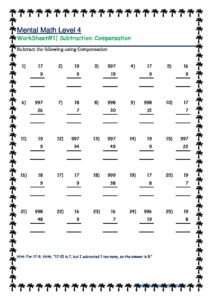Subtraction using compensation strategy
Subtraction using compensation strategy
Subtraction is a fundamental mathematical operation that involves finding the difference between two numbers. While basic subtraction may seem straightforward, mastering this concept is crucial for building a strong foundation in mathematics. One effective strategy to enhance subtraction skills is the compensation strategy. In this comprehensive guide, we will explore the compensation strategy in detail and provide a step-by-step explanation of how it can be used to solve subtraction problems. By the end of this article, you will have a solid grasp of this powerful technique and be well-equipped to tackle complex subtraction challenges.

Understanding the Compensation Strategy
The compensation strategy is a method that involves adjusting one or more numbers in a subtraction problem to make it easier to solve mentally. It relies on the concept that adding or subtracting the same value from both numbers in an equation does not change the result. This strategy is particularly useful when dealing with numbers that are close to multiples of ten or other convenient reference points.
Step-by-Step Guide to Subtraction Using the Compensation Strategy
Let’s dive into a step-by-step breakdown of how to use the compensation strategy to solve subtraction problems:
Identify the Numbers:
Begin by identifying the two numbers involved in the subtraction problem. For this example, let’s use the equation: 78 – 46.
Find a Reference Point:
Look for a reference point that is convenient to work with. In most cases, this will be a multiple of ten or a number that is close to it. In our example, we can choose 50 as our reference point because it’s close to 46.
Determine the Compensation:
Calculate the difference between the reference point and the number you want to subtract. In this case, the difference between 50 and 46 is 4.

Adjust the Numbers:
Now, adjust both numbers in the subtraction problem using the compensation value you calculated. Add 4 to both 78 and 46. This step ensures that the overall value of the equation remains unchanged. So, we have:
-
- 78 + 4 = 82
- 46 + 4 = 50
-
Simplify the Problem:
- Your equation has now been transformed into a simpler one: 82 – 50. This subtraction problem is more manageable and easier to solve mentally.
-
Solve the Simplified Problem:
- Subtract 50 from 82 to find the answer to the original problem: 82 – 50 = 32
-
Compensate for the Adjustment:
- Don’t forget to account for the compensation you made earlier. Since you added 4 to both numbers, subtract 4 from the result: 32 – 4 = 28
-
Final Answer:
- The final answer to the original subtraction problem, 78 – 46, is 28.
Practice Makes Perfect
To become proficient in using the compensation strategy, practice is essential. Here are some additional examples to help reinforce your understanding:
Example 1: 67 – 38
- Choose 40 as the reference point.
- Calculate the compensation: 40 – 38 = 2.
- Adjust the numbers: 67 + 2 = 69 and 38 + 2 = 40.
- Simplify: 69 – 40.
- Solve: 69 – 40 = 29.
- Compensate: 29 – 2 = 27.
- Final answer: 67 – 38 = 27.
Example 2: 96 – 57
- Choose 60 as the reference point.
- Calculate the compensation: 60 – 57 = 3.
- Adjust the numbers: 96 + 3 = 99 and 57 + 3 = 60.
- Simplify: 99 – 60.
- Solve: 99 – 60 = 39.
- Compensate: 39 – 3 = 36.
- Final answer: 96 – 57 = 36.
Example 3: 124 – 89
- Choose 90 as the reference point.
- Calculate the compensation: 90 – 89 = 1.
- Adjust the numbers: 124 + 1 = 125 and 89 + 1 = 90.
- Simplify: 125 – 90.
- Solve: 125 – 90 = 35.
- Compensate: 35 – 1 = 34.
- Final answer: 124 – 89 = 34.

Benefits of the Compensation Strategy
The compensation strategy offers several benefits for students learning subtraction:
- Improved Mental Math: It encourages students to perform mental calculations, enhancing their ability to do arithmetic in their heads.
- Greater Understanding: By breaking down the subtraction process into manageable steps, students gain a deeper understanding of mathematical concepts.
- Confidence Boost: Solving subtraction problems with the compensation strategy can boost students’ confidence, making math more enjoyable.
- Versatility: This strategy can be applied to various subtraction problems, from simple to complex, making it a valuable tool in a student’s mathematical toolkit.
- Preparation for Advanced Math: Mastering the compensation strategy lays a solid foundation for tackling more advanced math concepts and problem-solving techniques.
Conclusion
Subtraction is a fundamental mathematical skill, and the compensation strategy is a valuable tool that can help students improve their subtraction abilities. By selecting convenient reference points and making adjustments, students can simplify subtraction problems and build confidence in their mathematical capabilities. As with any skill, practice is key to mastery. Encourage students to apply the compensation strategy to various subtraction problems until they become proficient in using this technique. With dedication and practice, students can become skilled mathematicians, capable of solving complex subtraction problems with ease.

